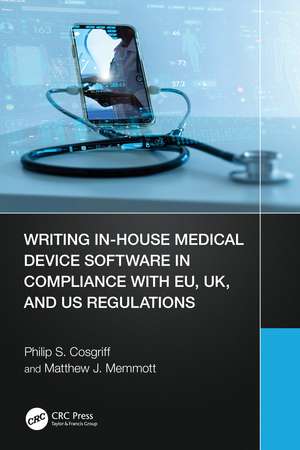Writing In-House Medical Device Software in Compliance with EU, UK, and US Regulations
Autor Philip S. Cosgriff, Matthew J. Memmotten Limba Engleză Paperback – 26 mar 2024
It compares requirements and latest regulations in different global territories, including the most recent EU regulations as well as UK and US regulations.
This book is a valuable resource for practising clinical scientists producing medical software in-house, in addition to other medical staff writing small apps for clinical use, clinical scientist trainees, and software engineers considering a move into healthcare. The academic level is post-graduate, as readers will require a basic knowledge of software engineering principles and practice.
Key Features:
- Up to date with the latest regulations in the UK, the EU, and the US
- Useful for those producing medical software for routine clinical use
- Contains best practice
| Toate formatele și edițiile | Preț | Express |
|---|---|---|
| Paperback (1) | 260.28 lei 3-5 săpt. | +43.06 lei 6-12 zile |
| CRC Press – 26 mar 2024 | 260.28 lei 3-5 săpt. | +43.06 lei 6-12 zile |
| Hardback (1) | 712.51 lei 6-8 săpt. | |
| CRC Press – 26 mar 2024 | 712.51 lei 6-8 săpt. |
Preț: 260.28 lei
Preț vechi: 325.35 lei
-20% Nou
Puncte Express: 390
Preț estimativ în valută:
49.80€ • 51.88$ • 41.52£
49.80€ • 51.88$ • 41.52£
Carte disponibilă
Livrare economică 07-21 martie
Livrare express 20-26 februarie pentru 53.05 lei
Preluare comenzi: 021 569.72.76
Specificații
ISBN-13: 9781032293509
ISBN-10: 1032293500
Pagini: 290
Ilustrații: 4 Tables, color; 13 Tables, black and white; 15 Line drawings, color; 16 Line drawings, black and white; 5 Halftones, color; 16 Illustrations, color; 20 Illustrations, black and white
Dimensiuni: 156 x 234 x 17 mm
Greutate: 1.18 kg
Ediția:1
Editura: CRC Press
Colecția CRC Press
ISBN-10: 1032293500
Pagini: 290
Ilustrații: 4 Tables, color; 13 Tables, black and white; 15 Line drawings, color; 16 Line drawings, black and white; 5 Halftones, color; 16 Illustrations, color; 20 Illustrations, black and white
Dimensiuni: 156 x 234 x 17 mm
Greutate: 1.18 kg
Ediția:1
Editura: CRC Press
Colecția CRC Press
Public țintă
Postgraduate and ProfessionalCuprins
1. Introduction. 2. The Need for In-House Development of Medical Software. 3. Types of Health Software. 4. Basic Concepts of Risk and Safety. 5. Standards and Guidelines. 6. Regulation of Medical Devices. 7. Best Practice and Legal Liability. 8. Security of Medical Devices. 9. Future Regulation of Medical Device Software. 10. Summary. Index.
Notă biografică
Philip S. Cosgriff worked as a clinical scientist (medical physicist) in the UK National Health Service for nearly 40 years, specialising mainly in nuclear medicine. He produced in-house data analysis software for that whole period, with an emphasis on software quality assurance. He was a UK delegate on a pioneering EU project (COST-B2) on quality assurance of nuclear medicine software, and he has contributed to numerous reports published by the UK Institute of Physics and Engineering in Medicine (IPEM). He retired from the NHS in 2016 but has remained professionally active, with continued contributions to IPEM publications and a chapter in a recently published book entitled Diagnostic Radiology Physics with MATLAB®. He is a recognised expert on the application of EU and US medical device legislation, as well as other consumer protection legislation that may affect the in-house medical software developer. His current interests include the application of AI methodologies to diagnostic imaging and the future role of medical apps.
Matthew J. Memmott is a consultant medical physicist based at Manchester University NHS Foundation Trust, with experience working as a clinical scientist in the UK National Health Service for over 15 years. He has previously published journal articles, book chapters and delivered talks at national and international conferences on topics ranging from Monte Carlo image generation, computational phantoms and cardiac positron emission tomography (PET‑CT) optimisation to dosimetry for radiation accident scenarios. He has a long‑standing interest in scientific programming, utilising various languages for analysis and simulation of ground truth quality assurance data; and commercial platforms for the development of in‑house clinical applications. He was a previous Chair of the UK Institute of Physics and Engineering in Medicine (IPEM) Nuclear Medicine Software Quality Group (NMSQG); a group which develops national audits to promote quality standards across departments utilising in‑house developed software, as well as commercial packages. His current interests are in modelling exposure scenarios from radiation accidents, developing ground‑truth computational phantoms for software quality assurance, investigating novel quantitative methods in PET‑CT studies and the potential applications of AI in nuclear medicine.
Matthew J. Memmott is a consultant medical physicist based at Manchester University NHS Foundation Trust, with experience working as a clinical scientist in the UK National Health Service for over 15 years. He has previously published journal articles, book chapters and delivered talks at national and international conferences on topics ranging from Monte Carlo image generation, computational phantoms and cardiac positron emission tomography (PET‑CT) optimisation to dosimetry for radiation accident scenarios. He has a long‑standing interest in scientific programming, utilising various languages for analysis and simulation of ground truth quality assurance data; and commercial platforms for the development of in‑house clinical applications. He was a previous Chair of the UK Institute of Physics and Engineering in Medicine (IPEM) Nuclear Medicine Software Quality Group (NMSQG); a group which develops national audits to promote quality standards across departments utilising in‑house developed software, as well as commercial packages. His current interests are in modelling exposure scenarios from radiation accidents, developing ground‑truth computational phantoms for software quality assurance, investigating novel quantitative methods in PET‑CT studies and the potential applications of AI in nuclear medicine.
Descriere
This book is a comprehensive guide to producing medical software for routine clinical use.
